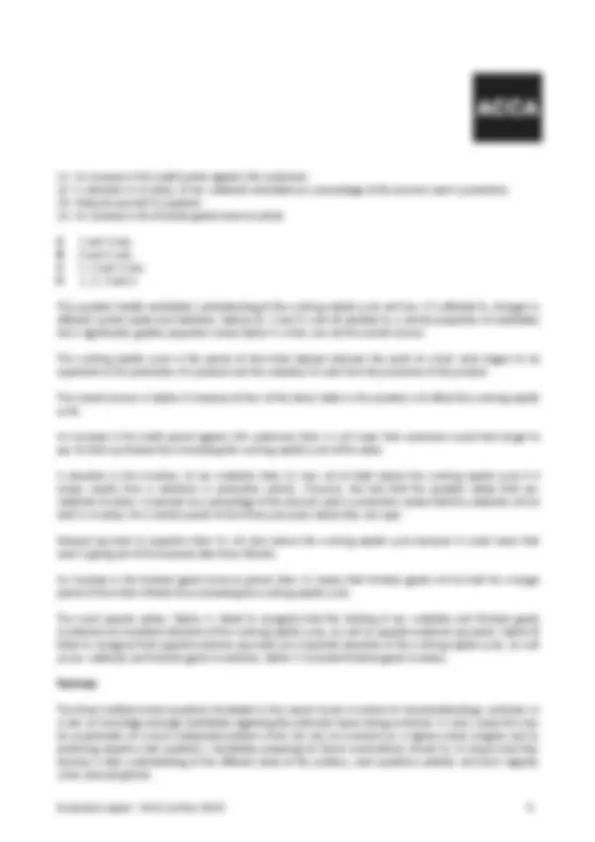



Study with the several resources on Docsity

Earn points by helping other students or get them with a premium plan


Prepare for your exams
Study with the several resources on Docsity

Earn points to download
Earn points by helping other students or get them with a premium plan
Community
Ask the community for help and clear up your study doubts
Discover the best universities in your country according to Docsity users
Free resources
Download our free guides on studying techniques, anxiety management strategies, and thesis advice from Docsity tutors
Example 1. An investment project has a positive net present value of $33,274 when discounted at the cost of capital of 10% per annum. The estimated net cash ...
Typology: Study notes
1 / 3

This page cannot be seen from the preview
Don't miss anything!


Examiner’s report – MA2 July-Dec 2015 1
General Comments
The examination consists of 50 objective test questions, each worth 2 marks. The purpose of this report is to provide illustrations of questions which have especially posed problems for candidates.
The three sample multiple-choice questions below cover different aspects of the syllabus. The approach to correctly answering each question is explained and the common incorrect approaches, along with the misunderstandings which they indicate, are highlighted. Answering objective test questions requires candidates to have both a clear understanding of the subject matter being examined and a logical approach.
Sample Questions for Discussion
Example 1
An investment project has a positive net present value of $33,274 when discounted at the cost of capital of 10% per annum. The estimated net cash inflows at the end of each year of the project’s five-year life are $64,000. The annuity factor at 10% per annum for five years is 3.791.
What is the investment amount in Year 0?
A $275, B $286, C $273, D $209,
This question tested candidates’ understanding of capital investment appraisal using discounted cash flow (DCF) analysis. The question required candidates to work backwards from the results of a DCF appraisal in order to determine the investment amount. All four options were popular with candidates.
The correct answer is Option D. The annuity factor at 10% per annum over a period of five years (3.791) is based on the same net cash flow arising at the end of each of the five years. It is multiplied by the figure of $64,000 to determine the present value (PV) of the net cash inflows. The resulting figure is $242,624. Because the net present value (NPV) of the investment project (i.e. PV of the net cash flows compared with the investment amount) is a positive $33,274 then the investment amount will be less than the PV of the net cash inflows by that amount. Thus the investment amount is $209,350 ($242,624 - $33,274).
Option A is incorrect because the positive NPV of $33,274 has been added to (rather than deducted from) the PV of the net cash inflows ($242,624 + $33,274 = $275,898). This assumes that the NPV is negative (i.e. that the investment amount is greater than the PV of the net cash inflows).
Examiner’s report – MA2 Jul-Dec 2015 2
Option B is incorrect because a factor of 5 (for the five years) has been applied to the annual net cash inflows [($64,000 × 5) - £33,274 = $286,726]. This assumes no discounting.
Option C is incorrect because a factor of 4.791 (rather than 3.791) has been applied to the annual net cash inflows [($64,000 × 4.791) - $33,274 = $273,350]. This incorrectly assumes that a further $64,000 is received as soon as the investment is made.
Example 2
Two products (X and Y) are produced jointly in a manufacturing process. Common process costs are apportioned on the basis of sales value. The following data relate to a period in which the common costs were $38,600: Product X Product Y Selling price at split-off point $8.00 per unit $15.00 per unit Selling price after further processing $10.00 per unit $18.00 per unit Output 2,500 units 2,300 units
What amount of the common process costs in the period will be apportioned to Product X?
A $14, B $14, C $20, D $13,
This question tested candidates’ ability to apportion joint process costs on the basis of sales value. All four options were selected by a significant proportion of candidates. Options B and C were equally popular, with Option A ( the correct answer) and Option D slightly less so.
In this question, further processing occurs after the split-off point in the joint process. Where the common process costs ( i.e. those incurred before the split-off point) are to be apportioned on the basis of sales value then it is the relative sales values of the joint products at the split-off point, rather than the final sales values after further processing, that are relevant. Also, sales value means the total sales values of the output of the products (X $20,000: Y $34,500) not just the selling prices (X $8.00: Y $15.00) in order to determine the appropriate weighting between the products.
Option A is the correct answer. The apportionment of common process costs to Product X is $14,165 [$38, × ($20,000 ÷ $54,500)].
Option B ($14,533) is incorrect because it uses final sales values, i.e. after further processing [$38,600 × ($25,000 ÷ $66,400)]. Option D ($13,426) is incorrect because the apportionment is based on the relative selling prices at the split-off point [$38,600 × ($8.00 ÷ $23.00)]. Option C ($20,104) is incorrect because it ignores sales prices/values entirely and instead bases the common cost apportionment on output quantities [$38,600 × (2,500 units ÷ 4,800 units)].
Example 3
Which of the following will affect the working capital cycle?